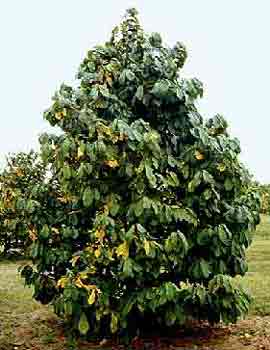 Pawpaw - Asimina triloba
Pawpaw - Asimina triloba
Custard Apple Family (Annonaceae)
Pawpaw grows in thickets in the forest understory and along woodland edges. It is the native plant that produces the largest berry in North America. The Kentucky champion tree is in Letcher County and is over 30 feet tall.
- Native habitat: Northern Florida to Western New York, northern shores of Lake Ontario, Southern Michigan to Southwestern Iowa, and west to Southeastern Nebraska, and eastern parts of Kansas, Oklahoma and Texas.
- Growth habit: Round, upright pyramid, with moderate density and coarse texture. Tree size: 15 to 20 feet tall, 15 to 20 feet wide; can grow to 30 to 40 feet tall in ideal locations. Growth rate is moderate.
- Flower and fruit: Flowers are nearly 2 inches across, pale green before turning brown, then maroon or purple. Pawpaw blooms in spring before leafout. Fruit is a 3- to 5-inch-long berry that is green when young then becomes dark and wrinkled when ripe in October or November. Ripe fruit has a flesh like custard and tastes a lot like bananas.
- Leaf: Alternate, simple, 4 to 10 inches long and 4 to 6 inches wide. Light green, turning yellow in fall. Hardiness: Winter hardy to USDA Zone 5.
There are at least 45 cultivars of pawpaw selected for their fruit characteristics. The national germplasm repository for pawpaw is at Kentucky State University in Frankfort, KY. Selected cultivars include:
- ‘Convis' - Large (up to 1 pound) fruits with yellow flesh. ‘Davis' - An older, popular plant from Michigan introduced in 1961. The fruit are less than ½-pound with yellow flesh.
- ‘Overleese' - Heavy producing plant with clusters of 1-pound fruits. Selected in Indiana.
- ‘Sunflower' - Produces 8-ounce fruit with a butter-yellow flesh. Said to be self-fertile. Selected in Kansas.
- ‘Wells' - This cultivar has fruit with green skin and orange flesh. Fruit are a little less than a pound. Collected in Indiana.
 Additional information:
Additional information:There has been great demand for pawpaw recently, not only because of its appealing ornamental characteristics and tastyfruit, but also because of its potential as a source of organic insecticide and for use in cancer therapy. An insecticide can be made from the tree's ground-up bark and twigs. Extract from pawpaw can overcome the ability of some cancer cells to reject chemotherapy.
On dormant stems, pointed buds are vegetative while flower buds are round and fuzzy. Cross-pollination is needed to get good fruit set in pawpaw. Pawpaw fruit develops in clusters. Fruit with orange flesh is considered the tastiest. The fruit attracts wildlife (especially raccoons, opossums, gray squirrels and birds). It also attracts the beautiful zebra swallowtail butterfly, giving added incentive for wildlife lovers to obtain the tree. It is an excellent source of vitamins A and C, and is high in unsaturated fats, proteins and carbohydrates. Pawpaws contain more potassium, phosphorus, magnesium and sulfur than apples, grapes or peaches.
 The first reference to pawpaw came in writings of Hernando DeSoto's expedition to the Mississippi Valley in 1541. The fruit, a favorite food of American Indians, was used to feed DeSoto's conquistadors. Early North American settlers used the fruit to make jelly, and the tree's inner bark to string fish. Indians in Louisiana used the inner bark to weave a fiber cloth.
The first reference to pawpaw came in writings of Hernando DeSoto's expedition to the Mississippi Valley in 1541. The fruit, a favorite food of American Indians, was used to feed DeSoto's conquistadors. Early North American settlers used the fruit to make jelly, and the tree's inner bark to string fish. Indians in Louisiana used the inner bark to weave a fiber cloth.
Although pawpaw is in great demand, it does have a disadvantage. Its fruit and foliage produce a great deal of litter. Planting only one tree can help alleviate the problem, as lack of cross-pollination leads to production of less fruit. Because they are broader at the tip than at the base the leaves droop, giving pawpaw a "sleepy" or tropical appearance.
The genus Asimina includes the only temperate members of this family. The tree, which is hard to transplant because of its wide root system, should be balled-and-burlapped and moved when it is less than 6 feet tall.


